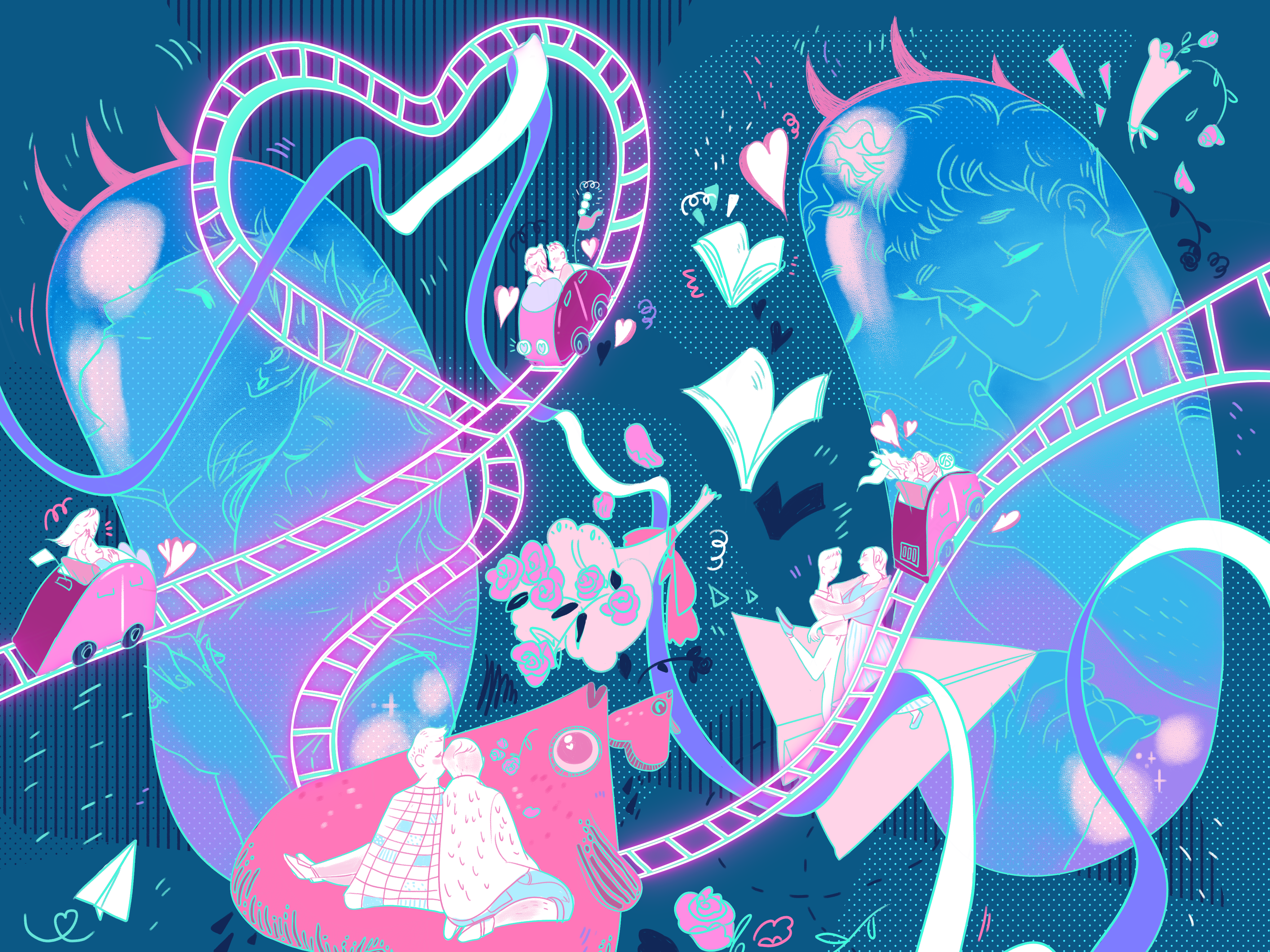I’d just watched a sex scene between two men who had, in the same episode, demonstrated sexual attraction for women.
Watching the fourth episode of Showtime’s Penny Dreadful was disorienting. I was sharing a laptop screen with my partner, binging our way through the first season of the supernatural murder mystery. The show had already hooked us in with its anything-goes take on classical horror, but that still didn’t prepare us for this particular episode’s deeply satisfying final scene.
This would take days to unpack. This wasn’t a revelation that Ethan Chandler and Dorian Gray were in fact gay, hiding their forbidden love from the world. That would have been a perfectly reasonable depiction of same-sex attraction, but as a bisexual viewer, not the one to grab my attention quite so powerfully. No, their sexualities were clearly more fluid.
It didn’t hurt that I could share this moment with my partner, who is also bisexual. We were both beyond thrilled; it had happened, and it meant something.
Ethan Chandler became my first clear point of identification in pop culture. There’s an odd contradiction here: as a cisgender white man, I see myself everywhere on screen. But as a bisexual man, the invisibility I experience in the real world is also, in its own way, replicated on screen.
I often don’t “present” as queer, beyond frequenting queer spaces. I shouldn’t have to go out of my way to avoid being mischaracterized as straight, but such is the world we live in. The default is straight. It’s assumed. If I’m with a man, though, I must be gay. There isn’t much space in between.
Even when stated plainly, my bisexuality isn’t necessarily believed or acknowledged. I’ve gotten laughs — nothing cruel, but more the sense that I must be joking. I still haven’t figured out the supposed punchline.
While I wasn’t actively yearning for characters who looked like me, recognizing the other ways I’d been let down by pop culture provided a powerful epiphany. Or rather, finally experiencing some form of rectification was remarkably satisfying.
“The default is straight. If I’m with a man, though, I must be gay. There isn’t much space in between.”
Watching Chandler and Gray kiss, undress, and get graphically amped up to do everything that comes after a fade out was affirming in a way I wasn’t used to. No explanations were needed. It wasn’t a ‘very special episode’ in which characters discuss issues and learn lessons. The two men just got to it, seemingly unconstrained by social expectations.
Bisexuality is certainly having something of a moment in pop culture — whether that’s living, breathing people like Janelle Monáe, Kristen Stewart, Anna Paquin and Amber Heard expressing attraction to more than one gender — or fictional characters coming out on-screen like Brooklyn Nine-Nine’s Rosa Diaz, Riverdale’s Cheryl Blossom and Toni Topaz and Grown-ish’s Nomi Segal.
But even with high-profile stars and characters embracing fluid sexual orientations, depictions of male bisexuality remain scarce. Actors Keiynan Lonsdale and Alan Cumming are two rare outspoken examples.
A rare standout is the character Oberyn Martell in HBO’s Game of Thrones. When told, in response to his attraction to men and women, that everyone has a preference, Martell asserts with utmost confidence that “everyone is missing half the world’s pleasure.”
“In pop culture, characters usually need to state that they’re bisexual or pansexual, or else be seen as straight or gay by default.”
While Ethan Chandler opened the door, in my mind, to bisexual representation, Oberyn Martell strutted through it with a level of confidence I’d not fully allowed myself. To see his own orientation not just as something different, but as something better? That was emboldening. My identity suits me. I get more out of it, just as I assume straight people get more out of theirs.
Seeing anyone who is recognizably bisexual on screen is an overwhelmingly validating experience. It not only offered a point of identification but also provides proof, odd as it may sound, that my experiences and identity are real. And it’s especially important because to be bisexual is often to be invisible.
We are often seen as straight or gay, depending on who we date or sleep with. In pop culture, characters usually need to state that they’re bisexual or pansexual, or else be seen as straight or gay by default.
Other times characters whose sexuality could be figured outside of the straight/gay binary tend to reject bisexuality — they either discover they were gay all along, or stop ‘experimenting’ and settle on one identity or the other.
I only recognized my own bisexuality well into adulthood, and I’m sure that was, at least in part, because of the stories in pop culture I consumed — or the pop culture that was available to me.
It’s an odd thing to grow up assuming that attraction to men is a normal part of straight masculinity, a reality we just didn’t talk about for one reason or another. In retrospect, some childhood friendships were clearly crushes, while some big screen role models inspired more than casual admiration.
Harrison Ford in Star Wars was my gold standard, along with Keanu Reeves in Speed. The movies of my childhood may not have offered bisexual representation, but they never lacked for objects of attraction.
I’m sure better sex ed would have helped. I remember positive messaging around being who you are and ‘accepting difference,’ but nothing to really articulate or anchor my own identity with. I hope today’s youths continue to receive a better education than I did.
But representation absolutely matters. This lack of representation meant I struggled with absurd questions, like “what does a bisexual man look like?” Well, we don’t all look alike, and most of us unfortunately don’t look like Josh Hartnett’s swoon-worthy character Ethan Chandler.
Despite the apparent foolishness of this question, it’s one I couldn’t help but carry with me because I had so little to go on.
“It’s an odd thing to grow up assuming that attraction to men is a normal part of straight masculinity.”
Watching Chandler, a man who doesn’t present as queer in any stereotypical ways and isn’t out to convince anyone, but does sleep with men and women on screen without ever remarking upon it is frankly radical. It reflects an authenticity of experience that doesn’t require belief or even recognition from anyone.
We have access, as viewers, to moments of privacy that obviously don’t translate to the real world, but therein lies the power of ‘The Scene’ from Episode 4. It makes me feel seen, and it also does the work of telling everyone else in the audience not to assume anything about other people’s sexual orientations.
Penny Dreadful isn’t a show about queerness. It would never be categorized as an LGBT series on Netflix. I didn’t go looking for representation of bisexual men in it. It was a complete surprise, and a welcome one at that.
That scene between Ethan Chandler and Dorian Gray in Penny Dreadful was undercut later by comments from actor Reeve Carney (who plays Gray), who all but erased any queer reading of it, pathologizing bisexuality as a symptom of personal demons more than anything else.
“I think it’s a response to a numbness within,” he told Logo, adding that Gray compulsively “takes it to the next level” like “a cutter” who self-harms.
But I’d seen the episode before reading Carney’s words, reducing bisexuality in the most ignorantly stereotyped ways. I’d had my moment before he could tarnish it off screen.
I’ve since enjoyed other examples of bisexual men on screen, and it’s honestly exciting every time.
Game of Thrones and Sense8 are particular high points for me, but others keep popping up here and there. Jane the Virgin introduced a bisexual man in Season 4, while Supergirl’s character Mon-El suggestively described his homeworld of Daxam as a “more the merrier” kind of place upon learning of homophobia on Earth.
It’s not all rosy, of course. Even media producers ostensibly making an effort have a tendency of reinforcing bisexual erasure. DC Comics’ John Constantine’s bisexuality hasn’t shown up in any of his onscreen incarnations, for instance. And an odd trend of media producers identifying bisexual or pansexual characters without offering any acknowledgement on screen has ensnared Deadpool’s eponymous anti-hero and Star Wars’ Lando Calrissian.
At the same time, things have been arguably getting better for bisexual men in recent years: bisexual or pansexual men do appear in pop culture, just not frequently. John Constantine and Deadpool (at least in the comic versions), Captain Jack Harkness from the television series Dr Who and Torchwood, Halt and Catch Fire’s Joe MacMillan, and House of Cards’ Frank Underwood are all leading men with fluid sexual attractions, not to mention all of the main characters — including the men — of Sense8.
I’m holding out hope for more representation of bisexual men on screen and in other pop culture. For myself and for younger viewers, who deserve to feel what I felt when Ethan’s sexuality was laid bare in Penny Dreadful, pun intended.
I hope for a day when such a scene isn’t so surprising.


 Why you can trust Xtra
Why you can trust Xtra


